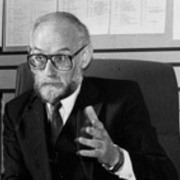
Arthur Everard
Arthur Everard graduated with an honours degree in psychology from Victoria University, where he was part of the group which launched the university film society. He also began writing classical music reviews for The Listener.
In 1965 Everard applied for a projectionist’s job at the Government’s National Film Unit. When asked why an honours graduate would want such a job, Everard replied that he liked movies. “Well would you like to make them?”. Everard’s reply was “too right”.
Soon after Everard was “thrown in the deep end”, as an apprentice at the NFU. Within a year he was handed the directing baton, often serving as a writer and editor as well.
One of the documentaries for which he performed all three roles was 1967’s To Live in the City which followed four young Māori, as they leave school and whānau for the city. A follow-up documentary (directed by Brian Lennane) chronicled what happened to them 24 years on.
Though much of the NFU’s output was necessarily touristic or “worthy” in nature, Everard enjoyed being given the freedom to take new approaches to familiar material. The documentary work ranged across shorts on metrics, the police force, dolphins and the arts - including a short on 19th century painter Gottfried Lindauer which he was forced to shorten by 20 minutes.
He also worked on more experimental music based pieces, including 1971‘s classically inspired Margan’s Musical Move, and Score, which set slow-motion footage of the French rugby team to Tchaikovsky. Score won a jury prize at the Montreal Film Festival.
Everard was part of the scrum of directors behind feature-length doco Games ’74, alongside Paul Maunder, Sam Pillsbury, and NFU veteran John King. This ambitious chronicle of the Christchurch Commonwealth Games screened in cinemas throughout New Zealand.
Everard writes here about developments in filmmaking technology during his time at the NFU.
After 19 years with the Film Unit, Everard was appointed Chief Film Censor in 1984.
His period in command continued the general liberalisation of censorship that had been signalled by the wording of the 1976 Cinematograph Films Act. The Act required films to be judged by a less stringent standard than before: whether a film was “likely to be injurious to the public good”; a move that shifted censorship away from a focus on public order and decency.
Everard’s six years as New Zealand’s chief film censor coincided with a massive growth in home viewing of films, thanks to the early 80s arrival of video recorders. In 1987 a new bill created two bodies specifically dealing with home viewing - one, run by the video industry, classified videos based on New Zealand film censor decisions, while a Video Recordings Authority was established to make decisions on more controversial material, thereby taking a large backlog of explicit sex videos out of the censor’s hands.
Everard found himself in the firing line over many censorship matters, including the controversial Hail Mary, and many videos that were no longer under his jurisdiction. In 1987 anti-pornography campaigner Patricia Bartlett labelled him New Zealand’s most permissive censor yet.
The same year Everard argued that the censor’s office had partly been under attack because it had tried to increase communication between public and censor, and get more feedback in order to better reflect community standards.
He also argued that technology was likely to outstrip legislation, allowing parents to show explicit videos to their children if they wanted: “What we’ve got to do is try to educate the public into the reasons for not showing this stuff to children, and also educate children to grow up into a situation where they can evaluate it and be critically analysing it themselves."
In 1990 Parliament passed the Films Amendment Act, which among other things imposed a limit of six consecutive years on how long a person could remain Chief Censor. Everard left office in 1991, and now argues that the act was rushed through with little consultation. Later changes would see this limit abolished. In 1994 video and film censors were merged with the Indecent Publications Tribunal into one overriding body, The Office of Film and Literature Classification.
Everard went on to evaluate and write information for the wine industry. He is currently busy chopping firewood, and catching up on the films he never used to have time to see.
Sources include
Arthur Everard